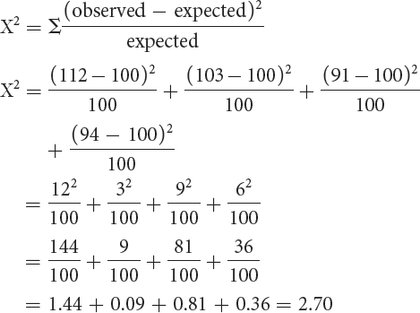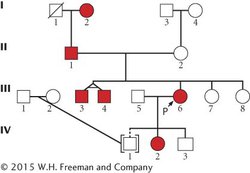WORKED PROBLEMS
67
WORKED PROBLEMS
Problem 1
In corn, purple kernels are dominant over yellow kernels, and full kernels are dominant over shrunken kernels. A corn plant with purple and full kernels is crossed with a plant with yellow and shrunken kernels and the following progeny are obtained:
| purple, full | 112 |
| purple, shrunken | 103 |
| yellow, full | 91 |
| yellow, shrunken | 94 |
What are the most likely genotypes of the parents and the progeny? Test your genetic hypothesis with a chi-
Solution Strategy
What information is required in your answer to the problem?
The genotypes of parents and progeny. A chi-
What information is provided to solve the problem?
Purple kernels are dominant over yellow kernels and full kernels are dominant over shrunken kernels.
The phenotypes of the parents.
The phenotypes and numbers of the different types of progeny of the cross.
For help with this problem, review:
Sections 3.3 and 3.4.
Solution Steps
The best way to begin this problem is to break the cross down into simple crosses for a single characteristic (seed color or seed shape):
Hint: A good strategy in a cross involving multiple characteristics is to analyze the results for each characteristic separately.
| P | purple × yellow | full × shrunken |
| F1 | 112 + 103 = 215 purple | 112 + 91 = 203 full |
| 91 + 94 = 185 yellow | 103 + 94 = 197 shrunken |
In this cross, purple × yellow produces approximately ½ purple and ½ yellow (a 1:1 ratio). A 1:1 ratio is usually the result of a cross between a heterozygote and a homozygote. Because purple is dominant, the purple parent must be heterozygous (Pp) and the yellow parent must be homozygous (pp). The purple progeny produced by this cross will be heterozygous (Pp), and the yellow progeny must be homozygous (pp).
Now let’s examine the other character. Full × shrunken produces ½ full and ½ shrunken, or a 1:1 ratio, so these progeny phenotypes are also produced by a cross between a heterozygote (Ff) and a homozygote (ff); the full-
Now combine the two crosses and use the multiplication rule to obtain the overall genotypes and the proportions of each genotype:
Recall: The multiplication rule states that the probability of two or more independent events occurring together is calculated by multiplying their independent probabilities.
| P | purple, full | × | yellow, shrunken |
| Pp Ff | pp ff | ||
| F1 Pp Ff = ½ purple × ½ full = ¼ purple, full | |||
| Pp ff = ½ purple × ½ shrunken = ¼ purple, shrunken | |||
| Pp Ff = ½ yellow × ½ full = ¼ yellow, full | |||
| Pp ff = ½ yellow × ½ shrunken = ¼ yellow, shrunken | |||
Our genetic explanation predicts that from this cross, we should see ¼ purple, full-
Could the difference between what we observe and what we expected be due to chance? If the probability is high that chance alone is responsible for the difference between observed and expected values, we will assume that the progeny have been produced in the 1:1:1:1 ratio predicted for the cross. If the probability that the difference between observed and expected values is due to chance is low, we will assume that the progeny are not really in the predicted ratio, and that some other, significant factor must be responsible for the deviation from our expectations.
The observed and expected numbers:
| Phenotype | Observed | Expected |
|---|---|---|
| purple, full | 112 | ¼ × 400 = 100 |
| purple, shrunken | 103 | ¼ × 400 = 100 |
| yellow, full | 91 | ¼ × 400 = 100 |
| yellow, shrunken | 94 | ¼ × 400 = 100 |
68
To determine the probability that the difference between the observed and expected numbers is due to chance, we calculate a chi-
Hint: See Figure 3.12 for help on how to carry out a chi-

Now that we have the chi-
Problem 2
Joanna has “short fingers” (brachydactyly). She has two older brothers who are identical twins; both have short fingers. Joanna’s two younger sisters have normal fingers. Joanna’s mother has normal fingers, and her father has short fingers. Joanna’s paternal grandmother (her father’s mother) has short fingers; her paternal grandfather (her father’s father), who is now deceased, had normal fingers. Both of Joanna’s maternal grandparents (her mother’s parents) have normal fingers. Joanna marries Tom, who has normal fingers; they adopt a son named Bill, who has normal fingers. Bill’s biological parents both have normal fingers. After adopting Bill, Joanna and Tom produce two children: an older daughter with short fingers and a younger son with normal fingers.
Using standard symbols and labels, draw a pedigree illustrating the inheritance of short fingers in Joanna’s family.
What is the most likely mode of inheritance for short fingers in this family?
If Joanna and Tom have another biological child, what is the probability (based on your answer to part b) that this child will have short fingers?
Solution Strategy
What information is required in your answer to the problem?
A pedigree to represent the family, drawn with correct symbols and labeling.
The most likely mode of inheritance for short fingers.
The probability that Joanna and Tom’s next child will have short fingers.
What information is provided to solve the problem?
The phenotypes of Joanna and Tom and their family members.
For help with this problem, review:
The information on pedigrees in Section 3.5.
Solution Steps
Hint: See Figure 3.13 for a review of symbols used in a pedigree.
In the pedigree for the family, use filled circles (females) and filled squares (males) to represent persons with the trait of interest (short fingers). Connect Joanna’s identical twin brothers to the line above by drawing diagonal lines that have a horizontal line between them. Enclose Bill, the adopted child of Joanna and Tom, in brackets; connect him to his biological parents by drawing a diagonal line and to his adopted parents by a dashed line.
69

Hint: See Analysis of Pedigrees for a review of characteristics of dominant and recessive traits in pedigrees.
The most likely mode of inheritance for short fingers in this family is dominant. The trait appears equally in males and females and does not skip generations. When one parent has the trait, it appears in approximately half of that parent’s sons and daughters, although the number of children in the families is small.
If having short fingers is a dominant trait, Tom must be homozygous (bb) because he has normal fingers. Joanna must be heterozygous (Bb) because she and Tom have produced both short-
fingered and normal- fingered offspring. In a cross between a heterozygote and a homozygote, half the progeny are expected to be heterozygous and half homozygous (Bb × bb→ ½ Bb, ½ bb); so the probability that Joanna’s and Tom’s next biological child will have short fingers is ½.